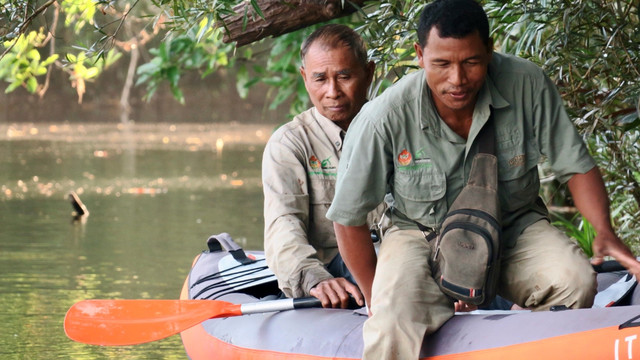Tackling the illegal wildlife trade through community-based approaches: building evidence on what works
Local communities are the first line of defence in tackling the illegal wildlife trade. But there's little information on initiatives involving local people. IIED's new database aims to gather more evidence on approaches that work, those that don't – and why.



Signs welcome visitors to the Sunderban Tiger Reserve in India. Wandering tigers still kill humans in the region, but this reserve generates employment and ecosystem benefits and other income for local people (Rick Hobson, Creative Commons via Flickr)
The illegal wildlife trade – particularly the poaching of high value, iconic species such as elephants, rhinos and tigers – tops the international conservation agenda. From Barack Obama to Prince William and a long list of high-profile celebrities, many influential people across the world are calling for action to stop this destructive trade.
The rise in international attention is reflected in the scale of investment committed to tackling this problem – over US$1.3 billion since 2010. So far, much of this money has been allocated to conservation efforts that reduce demand for illegal products such as rhino horn or tiger bone, and strengthen law enforcement in the fight against this illegal trade.
But protecting wildlife is not just a concern for conservationists; the economic and social value of endangered species makes their survival crucial to the local communities living alongside them. It is vital that more is done to involve local people in protecting this wildlife.
Untapped local intelligence
Because of their proximity and knowledge of wildlife, local people are well placed to participate in efforts to combat poaching and the illegal trade.
Yet only 15 per cent of the $1.3 billion invested since 2010 has been allocated to initiatives to engage local communities in helping to fight wildlife crime. Why?
Many global policy commitments recognise the role of local communities. But there is little information out there on initiatives involving local people, or how to implement them.
How effective are community-based approaches?
To help address this gap, and increase communities' involvement in tackling illegal wildlife trade, IIED has worked to identify as many local initiatives as possible. By reviewing literature and encouraging submissions to our online Communities, Crime and Conservation database, we found 49 such initiatives.
As our new report, First line of defence? A review of evidence on the effectiveness of engaging communities to tackle illegal wildlife trade, shows, local communities are using a range of practices.
One is the Mali Elephant Project. Deteriorating security in the remote Gourma region has meant little or no protection for the area's West African elephants. Amid escalating poaching, the community is providing much needed intelligence on suspicious activities, preventing a bad situation from becoming even worse.
The report features a wide variety of different community-based approaches, including direct involvement in anti-poaching activities, income generation schemes, and local conservation incentives such as developing wildlife tourism.
We found that most initiatives follow the four key forms of action that IIED has identified as being effective in reducing poaching:
- Strengthening disincentives for illegal behaviour
- Increasing incentives for wildlife stewardship
- Decreasing costs of living with wildlife, and
- Supporting non-wildlife related livelihoods.
But above all, we found that much more needs to be done to address the severe lack of evidence showing the steps that local communities are taking to protect the endangered wildlife around them.
The need for new evidence
Of the 49 initiatives, only 26 report on whether or not they are effective and just seven clearly assess their effectiveness. From this small pool we can draw some broad lessons – for example, the importance of multi-stakeholder partnerships, long-term engagement and context-specific solutions.
Share your experience: IIED's Conservation Crime and Communities database
Building meaningful evidence showing what works, and what doesn't work and why, is key.
 Through our new Conservation, Crime and Communities database we have created a way for those who run projects, as well as others in the field including researchers and funders, to submit a case study and share their valuable experience. The evidence gathered will help to develop a clear system of best practice.
Through our new Conservation, Crime and Communities database we have created a way for those who run projects, as well as others in the field including researchers and funders, to submit a case study and share their valuable experience. The evidence gathered will help to develop a clear system of best practice.
We're not suggesting that community-based approaches are the silver bullet that will end the current poaching crisis. But they can go a long way to complementing formal law enforcement efforts and help to avoid some of the impacts of top-down strategies that can undermine local incentives to protect wildlife.
Only by collectively building an understanding of approaches that work will we be able to increase the effectiveness of local communities' efforts to stop the rise in the illegal trade of endangered species.
Go to http://communitiesforwildlife.iied.org to contribute examples of community action.
Francesca Booker is a researcher on biodiversity at IIED; Dilys Roe (dilys.roe@iied.org) is principal researcher and team leader, biodiversity, in IIED's Natural Resources research group.



